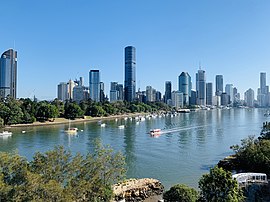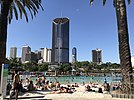Alahuela
Script error: The module returned a nil value. It is supposed to return an export table.
Alahuela | |
|---|---|
| Cidade Federal de Alahuela Federal City of Alahuela | |
| Motto(s): "Justitia Omnibus" (Latin) "Justice for all" | |
 | |
| Country | |
| Founded | 1710 |
| Government | |
| • Type | Mayor-Council |
| • Body | City Council |
| • Mayor | Danila Maniotti (SDP) |
| Area | |
| • Total | 1,019.4 km2 (393.6 sq mi) |
| • Land | 1,010.1 km2 (390.0 sq mi) |
| • Water | 9.3 km2 (3.6 sq mi) |
| Population (2020) | |
| • Total | 1,970,183 |
| • Density | 1,900/km2 (5,000/sq mi) |
| PEP code | 20001-20099 |
| Area code | 204/336/591/630 |
| Website | Official City Website |
Alahuela, officially the City of Alahuela, is the federal capital and seat of government of Cartadania. The city is located at the coastal border of Alexandria and Verona in the country's Luson region. It was founded on April 17, 1710, to serve as the new national capital. The city forms the core of the National Metro area, along with four counties from the state of Alexandria and two from Verona. The Constitution of Cartadania authorized the establishment of a capital region under the sole jurisdiction of the federal government and is therefore not a part of any state, but an independent city of Cartadania.
All three branches of Cartadania's federal government are centered in the city: executive, legislative, and judiciary. Alahuela also hosts 26 foreign embassies. The city utilizes Alahuela-Siqueira International Airport connects it to all other major Cartadanian cities and many international destinations, though it is within an hour drive of Palmdale International Airport in Everglade County in Verona and Saint Thomas International Airport in Rieti County in Alexandria.
History
Alahuela has served as the de facto capital of Cartadania since April of 1710 and the de jure capital since October 30, 1710. The city was formed from the land of Aralina County ceded by the state of Alexandria in 1709. The federal government initially returned a large portion of the land back to Alexandria, stating that the land area it had been granted was "far too much", but after six months of delegation and planning for the future of the national capital, the Senate and House of Representatives accepted all of 1,010 kilometers of Aralina County. Though not as apparent in the early 18th century when the then-county only registered 200,000 citizens, the now-district has swelled to 2 million residents in 2020, pushing the city's density to 1,950.5 people per square kilometer (5,051.8 people per mi2), well beyond what the 1st National Congress had predicted.
Background

Alahuela, as a city, was originally planned to be constructed further west, between the states of Alexandria and Venice. Prior to the decision to construct a new capital city, Cartadania's capital was the city of Alexandria on the island of Graciosa, which has since been ceded to the state of San Rícardo. The decision to abandon that location came when the importance of maritime travel was truly recognized by the federal government, which would lead to the search for a more opportune location. Before the city was to be planned as an independent city, options came up to make Sierra, which is the most populous city in the country with 8 million residents, the capital of Cartadania, but this idea was ultimately abandoned due to population concerns and the oversight of Verona's government on the city. This latter fear also ended the possibility of making Calaine, the capital of Alexandria, the capital of Cartadania. Consequently, the federal government would unsurprisingly decide to create a special district, equal to the states, where the nation's capital would lie.
Construction
Beginning in August of 1709, the state of Alexandria allocated 1,010km2 from then-Aralina County to be used by the federal government to construct a national capital. The state, along with the Commonwealth of Verona, assisted the federal government in constructing the city. The city was to be divided into six districts that would serve as sub-units of the district. From there, each entity (Alexandria, Verona, and the Federal Government) went about building two districts each, following a general plan drafted by Congress. The decision to do so has even gone so far as to be reflected in the city's architectural layout.

On October 10, 1715, the Cartadanian federal government, under the oversight of the President Iohannes Lucio, officially cut the ribbon to the city. Throughout the six years it took to get the federal city officially laid out and "online", the original Presidential Campus, Congress, and Supreme Court buildings were constructed.
Alahuela's first governor, Calidorus Vespillo, authorized large-scale projects that greatly modernized the City of Alahuela during the 1850s, but ultimately went so far as to bankrupt the district's government. In 1874, Congress replaced the territorial government with an appointed three-member Board of Commissioners.
Alahuela's urban plan of the 1870s was further expanded throughout the district in the following decades. The Riso district's street grid and other administrative details were formally merged to those of the new City of Alahuela in 1895. However, the city had poor housing conditions and strained public works. The district was one of the first cities in the nation to undergo urban renewal projects as part of the "City Beautiful movement" in the early 1900s.
The Great War sparked further development in and migration to the city, causing the city's population to explode to nearly 1 million residents. Because of the proximity to Alahuela, Verona's Cara County also exploded in population, far-overtaking the national capital in population and development. On the other side of the district, Rieti County in Alexandria also saw a very large increase in development and population relative to the national capital. These counties serve as the homes for many of the people who work in the national capital and the nearly seamless border between the localities of the National Metro area makes the even more apparent.
Twenty-first century
Today, Alahuela is a very affluent and global city.
Geography
Climate
Alahuela has a year-round hot trade-wind tropical rainforest climate (Af). Relative humidity fluctuates throughout the year with the highest occurring in May, June, August and December–January; these months are usually the rainiest part of the year. Between the months of September to November relative humidity is lower ushering in the drier season. Alahuela does not have a true dry season as monthly precipitation in all 12 months is above 72 millimetres (2.8 in), but the city does experience noticeably wetter and drier periods during the year. The northern hemisphere “autumn” (September through November) is the driest period of the year in Alahuela, and the heaviest rainfall occurs from April to July. Common to many cities with this climate, temperatures are relatively consistent throughout the course of the year, with average high temperatures of 31 °C (88 °F) and average low temperatures of 22 °C (72 °F). Because of its location, Alahuela's temperatures are moderated by the North-East trade winds blowing in from the Odoneru, so it rarely sees temperatures outside these limits.
| Climate data for Alahuela | |||||||||||||
|---|---|---|---|---|---|---|---|---|---|---|---|---|---|
| Month | Jan | Feb | Mar | Apr | May | Jun | Jul | Aug | Sep | Oct | Nov | Dec | Year |
| Average high °C (°F) | 28.6 (83.5) |
28.9 (84.0) |
29.2 (84.6) |
29.5 (85.1) |
29.4 (84.9) |
29.2 (84.6) |
29.6 (85.3) |
30.2 (86.4) |
30.8 (87.4) |
30.8 (87.4) |
30.2 (86.4) |
29.1 (84.4) |
29.6 (85.3) |
| Daily mean °C (°F) | 26.1 (79.0) |
26.4 (79.5) |
26.7 (80.1) |
27.0 (80.6) |
26.8 (80.2) |
26.5 (79.7) |
26.6 (79.9) |
27.0 (80.6) |
27.5 (81.5) |
27.6 (81.7) |
27.2 (81.0) |
26.4 (79.5) |
26.8 (80.2) |
| Average low °C (°F) | 23.6 (74.5) |
23.9 (75.0) |
24.2 (75.6) |
24.4 (75.9) |
24.3 (75.7) |
23.8 (74.8) |
23.5 (74.3) |
23.8 (74.8) |
24.2 (75.6) |
24.4 (75.9) |
24.2 (75.6) |
23.8 (74.8) |
24.0 (75.2) |
| Average rainfall mm (inches) | 185.2 (7.29) |
88.5 (3.48) |
111.0 (4.37) |
140.5 (5.53) |
285.5 (11.24) |
327.7 (12.90) |
268.0 (10.55) |
201.4 (7.93) |
97.5 (3.84) |
107.2 (4.22) |
185.9 (7.32) |
261.9 (10.31) |
2,260.3 (88.99) |
| Average rainy days (≥ 1.0 mm) | 16 | 10 | 10 | 12 | 19 | 23 | 21 | 15 | 9 | 9 | 12 | 18 | 174 |
| Mean monthly sunshine hours | 201.0 | 208.6 | 219.7 | 197.9 | 178.8 | 156.7 | 201.6 | 233.7 | 229.8 | 235.3 | 210.9 | 186.6 | 2,460.6 |
| [citation needed] | |||||||||||||
Urban layout
Localities (districts)
Cityscape
Demographics
Crime
Religion
Economy
Industries
Services
Tourism
Government and politics

The City of Alahuela officially sits within the district of the same name, which serves as an equivalency to the 31 states. Therefore, Alahuela is considered by many to be a state. It is officially, however, an independent city of Cartadania. Nevertheless, the city possess much the same power as the states that neighbor it and Alahuela has an equal power in Cartadania's legislature. The federal government allocates three senators and three representatives to the city so that it's residents may have the power to affect federal elections. The city's government functions in much the same way a state would, being divided into eight districts with it's seat of government being located in the Colina de Prado barrio of the Giulia district.
Similarly to the city's government, the seat of the federal government is also located in the Colina de Prado barrio of Giulia. City hall is a block away from the Capitol Building where Congress meets. Alahuela being a directly controlled city of Congress via a special council, which in turn acts as a state legislature for Alahuela in place of it's own citywide legislature, this proximity has historically made communication between the two very convenient.

Alahuela has a two-tier city judiciary–the lower-level District Court, and the upper-level Court of Appeals, both housed within the Alahuela Superior Court building. Cases appealed beyond the Alahuela Court of Appeals go to the Cartadanian First Circuit Courthouse, located in LaMarque, Verona.

Though Congress does retain control over the city, the city is primarily administered through its local government rather than the Alahuela Capital Authority, which is the arm of Congress that oversees the city. ACA stands primarily to make sure things run smoothly within the city and authorizes interstate legislation within the city, such as the Capital Area Metro Authority, which operates buses in the city, as well as the surrounding metro area counties in both Verona and Alexandria.
Alahuela's government is primarily dominated by the Social Democracy Party, as area much of the more populated and urbanized areas of Cartadania. Nonetheless, once approximately every four to six years, one of its representative seats flips to a United Conservative Party member, and once every twelve to sixteen years, it is UCP dominated.
All civilian police duties and services in the city are handled by Alahuela Metropolitan Police Department, which has authority from federal, state, and local equivalencies. While Cartadania itself has no federal civilian police department, the various agencies (e.g., the Department of Justice) work with AMPD on various tasks, and its not uncommon to see various agencies' officers at crime scenes.
Education
The school district responsible for education in Alahuela, City of Alahuela Public Schools (CAPS), operates the city's 215 public schools and enrolls 233,086 students as of 2022. There are 25 high schools, 26 middle schools, 160 elementary schools, and 4 alternative education campuses. The district has an annual operating budget of €5.3 billion, spending about €22,737 per student.
The District is also home to 92 private schools, which enrolled approximately 18,000 students in 2010. The Alahuela Public Library operates 25 neighborhood locations including the landmark Corsetti Memorial Library.

Private universities include Alahuela University (AU), the Catholic University of Cartadania (UCC), Gordon University, Hartford University (HU), Piguet University. The Crelo College of Art and Design provides specialized arts instruction and other higher-education institutions offer continuing, distance and adult education. The Erudite University of Alahuela (EUA), EUA's School of Advanced International Studies (SAIS), and the Giulia Capital Institute (GCI) are the public universities providing undergraduate and graduate education to Alahuela residents, all located within District 6 (Giulia). Alahuela residents are eligible for a grant of up to €12,000 per year to offset the cost of tuition at any public university in the country, although with the creation of HREB's SmartOne policy, students in Alahuela can attend any public university in Alexandria, Roma Alta, Roma Sur, Santiago, Trentino, Veneza, Verona, or the city of Alahuela itself tuition-free.
The city is known for its medical research institutions such as Alahuela Hospital Center and the Children's National Medical Center, as well as the National Institutes of Health in LaMarque, Verona. In addition, the city is home to three medical schools and associated teaching hospitals at Erudite, GCI, and Gordon universities.






